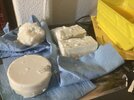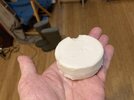Not something to eat, but I made it in the kitchen. I was looking at a mason jar full of bacon grease wondering what to do with it. I have plenty of lard rendered up and didn't need any more.
Why not make soap?
My ancient book on how to do essential things on the farm went missing, but I did find a soap calculator for the basic ingredients:
http://www.thesoapcalculator.com/
So, having 16 oz of lard, 2.2 oz pure lye, and 6.1 oz (by weight) of water. They called for distilled, but, feeling dangerous, I ran with tap.
First, the bacon fat smelled like bacon. I wasn't sure how much I want bacon-scented soap. I decided to do some water rendering of the fat. That is basically just adding a modest amount of water to the fat and heating to a slow boil for a while. Before that, I took some weights of the pure collected bacon fat in a known volume for a density figure. I wasn't sure if that would change after the boil-rendering, so I did it again after the fact. Sure enough, the rendered lard ended up with an additional 2% water by weight. I figured that was important given the emphasis on precision for the ingredients that I saw in various places on the web. (As a side note, I did this with beef tallow 20+ years ago. I wasn't nearly as precise and it worked out well enough).
After pouring off the white rendered grease and leaving the water behind, I let it set for a while to separate further. I noticed that the bacon scent was all but gone.
I prepared the lye solution. I spent my formative years in a chem lab, so I was well aware about mixing NaOH and water. Always, slowly, add lye to water, not the other way around. The other way around is likely to yield a nifty boil-over or worse. Also, I wore nitrile gloves, lab coat, and safety glasses, just as if I were in a lab, because I cherish my skin and eyes.
After the lye solution is mixed, it will get hot. Did I mention you mix it in something tolerant of heat? Well, be sure to do that. I used a large Pyrex measuring cup. Also, another after-the-fact warning: don't use aluminum for anything. Lye is very effective in etching aluminum and the byproduct is hydrogen gas. In my wayward youth I found many entertaining applications of that fact. I believe many of those applications violate federal law these days.
The object is to get your rendered lard and your lye solution to be approximately the same temperature. My thermometer had them both around 100F. Pour the lard into a mixing bowl ( I used Corel) and then slowly pour in the lye solution.
Now mix.
Using a spoon will take forever. An egg beater will throw caustic stuff around. The how-to-make-soap websites extol the virtues of a frothing mixer to accomplish this well. I don't own such a device, but I do own a whole bunch of power tools, including a cordless drill. I bent the end of a 1/16" piece of steel welding rod into an "ell" shape, chucked it in the drill, and away I went. It worked swimmingly.
You want to mix it all up so there are no streaks of oil anywhere. In the end it looks like runny batter.
Then you pour it into molds and let it sit for a couple of days. I had a large plastic cap and a plastic parts bin handy, and that was just enough. Next time I will line the molds with some parchment paper or freezer paper to ease removal.
This is called the "cold process method" of making soap. It apparently is all the rage among hand-crafties.
After the two day wait, you can remove from the molds. The recommendation is to let it sit for up to four weeks to properly cure.
Here is what I ended up with:


The blob on the left in the first picture was from the remains of digging the square pieces out of the mold. That is why it is a good idea to line the molds.
I haven't aged them for the four weeks yet. But I took some crumbs from the blob and washed my hands after welding things in the shop. My hands were pretty dark from the metal oils. The soap crumbs cleaned better than Goop hand cleaner. I am really pleased with this stuff.
It smells like unscented soap, it works up a decent lather with a shaving brush. What more do I need?
Postscript:
After doing various internet searches for soap recipes, the cloud algorithm started sending me soap ads from Dr. Squatch soap. It's supposed to help you regain your lost manhood, is made by the "cold process method," and costs a lot of money. The Dr. Squatch spokesman has this annoying habit of insulting regular guys who buy soap based upon their mother's recommendation. I frankly found it awful.
But it triggered an idea. Next time I won't wash out the bacon scent and challenge Dr. Squatch at his own game. He sells "manly scented soap" like Irish Creme & Whiskey or Frosted Peppermint. Sure there is pine tar scent too.
But what could be more manly than "bacon scent"? I could even chop up some crispy bits to add abrasion. "Aye!"
Nevermind.... I am an unscented clean-hands-at-the-end-of-the-day sort of guy. An easy project well done is satisfaction enough.
Why not make soap?
My ancient book on how to do essential things on the farm went missing, but I did find a soap calculator for the basic ingredients:
http://www.thesoapcalculator.com/
So, having 16 oz of lard, 2.2 oz pure lye, and 6.1 oz (by weight) of water. They called for distilled, but, feeling dangerous, I ran with tap.
First, the bacon fat smelled like bacon. I wasn't sure how much I want bacon-scented soap. I decided to do some water rendering of the fat. That is basically just adding a modest amount of water to the fat and heating to a slow boil for a while. Before that, I took some weights of the pure collected bacon fat in a known volume for a density figure. I wasn't sure if that would change after the boil-rendering, so I did it again after the fact. Sure enough, the rendered lard ended up with an additional 2% water by weight. I figured that was important given the emphasis on precision for the ingredients that I saw in various places on the web. (As a side note, I did this with beef tallow 20+ years ago. I wasn't nearly as precise and it worked out well enough).
After pouring off the white rendered grease and leaving the water behind, I let it set for a while to separate further. I noticed that the bacon scent was all but gone.
I prepared the lye solution. I spent my formative years in a chem lab, so I was well aware about mixing NaOH and water. Always, slowly, add lye to water, not the other way around. The other way around is likely to yield a nifty boil-over or worse. Also, I wore nitrile gloves, lab coat, and safety glasses, just as if I were in a lab, because I cherish my skin and eyes.
After the lye solution is mixed, it will get hot. Did I mention you mix it in something tolerant of heat? Well, be sure to do that. I used a large Pyrex measuring cup. Also, another after-the-fact warning: don't use aluminum for anything. Lye is very effective in etching aluminum and the byproduct is hydrogen gas. In my wayward youth I found many entertaining applications of that fact. I believe many of those applications violate federal law these days.
The object is to get your rendered lard and your lye solution to be approximately the same temperature. My thermometer had them both around 100F. Pour the lard into a mixing bowl ( I used Corel) and then slowly pour in the lye solution.
Now mix.
Using a spoon will take forever. An egg beater will throw caustic stuff around. The how-to-make-soap websites extol the virtues of a frothing mixer to accomplish this well. I don't own such a device, but I do own a whole bunch of power tools, including a cordless drill. I bent the end of a 1/16" piece of steel welding rod into an "ell" shape, chucked it in the drill, and away I went. It worked swimmingly.
You want to mix it all up so there are no streaks of oil anywhere. In the end it looks like runny batter.
Then you pour it into molds and let it sit for a couple of days. I had a large plastic cap and a plastic parts bin handy, and that was just enough. Next time I will line the molds with some parchment paper or freezer paper to ease removal.
This is called the "cold process method" of making soap. It apparently is all the rage among hand-crafties.
After the two day wait, you can remove from the molds. The recommendation is to let it sit for up to four weeks to properly cure.
Here is what I ended up with:


The blob on the left in the first picture was from the remains of digging the square pieces out of the mold. That is why it is a good idea to line the molds.
I haven't aged them for the four weeks yet. But I took some crumbs from the blob and washed my hands after welding things in the shop. My hands were pretty dark from the metal oils. The soap crumbs cleaned better than Goop hand cleaner. I am really pleased with this stuff.
It smells like unscented soap, it works up a decent lather with a shaving brush. What more do I need?
Postscript:
After doing various internet searches for soap recipes, the cloud algorithm started sending me soap ads from Dr. Squatch soap. It's supposed to help you regain your lost manhood, is made by the "cold process method," and costs a lot of money. The Dr. Squatch spokesman has this annoying habit of insulting regular guys who buy soap based upon their mother's recommendation. I frankly found it awful.
But it triggered an idea. Next time I won't wash out the bacon scent and challenge Dr. Squatch at his own game. He sells "manly scented soap" like Irish Creme & Whiskey or Frosted Peppermint. Sure there is pine tar scent too.
But what could be more manly than "bacon scent"? I could even chop up some crispy bits to add abrasion. "Aye!"
Nevermind.... I am an unscented clean-hands-at-the-end-of-the-day sort of guy. An easy project well done is satisfaction enough.
